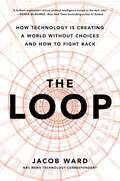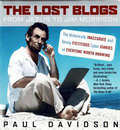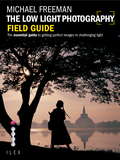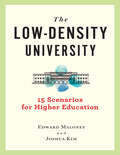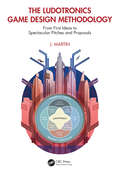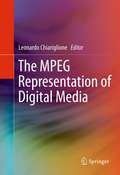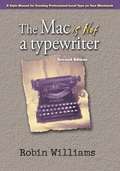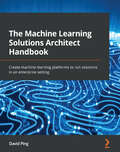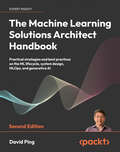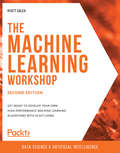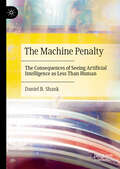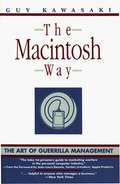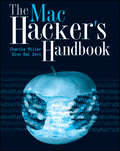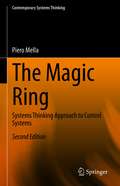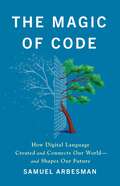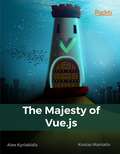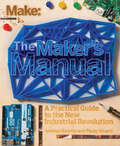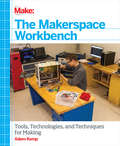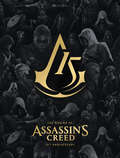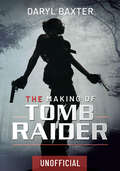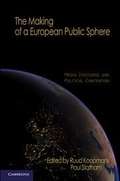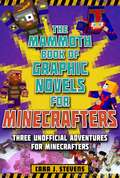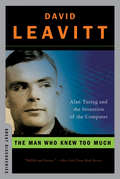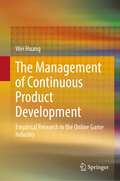- Table View
- List View
The Loop: How Technology Is Creating a World Without Choices and How to Fight Back
by Jacob WardThis eye-opening narrative journey into the rapidly changing world of artificial intelligence reveals the dangerous ways AI is exploiting the unconscious habits of our minds, and the real threat it poses to humanity: "The best book I have ever read about AI" (New York Times bestselling author Roger McNamee). Artificial intelligence is going to change the world as we know it. But the real danger isn't some robot that's going to enslave us: It's our own brain. Our brains are constantly making decisions using shortcuts, biases, and hidden processes—and we're using those same techniques to create technology that makes choices for us. In The Loop, award-winning science journalist Jacob Ward reveals how we are poised to build all of our worst instincts into our AIs, creating a narrow loop where each generation has fewer, predetermined, and even dangerous choices. Taking us on a world tour of the ongoing, real-world experiment of artificial intelligence, The Loop illuminates the dangers of writing dangerous human habits into our machines. From a biometric surveillance state in India that tracks the movements of over a billion people, to a social media control system in China that punishes deviant friendships, to the risky multiple-choice simplicity of automated military action, Ward travels the world speaking with top experts confronting the perils of their research. Each stop reveals how the most obvious patterns in our behavior—patterns an algorithm will use to make decisions about what's best for us—are not the ones we want to perpetuate. Just as politics, marketing, and finance have all exploited the weaknesses of our human programming, artificial intelligence is poised to use the patterns of our lives to manipulate us. The Loop is call to look at ourselves more clearly—our most creative ideas, our most destructive impulses, the ways we help and hurt one another-so we can put only the best parts of ourselves into the thinking machines we create.
The Lost Blogs: From Jesus to Jim Morrison
by Paul DavidsonThere are over 13 million people in the world currently blogging, but what about the blogs written by the iconic men and women who (unfortunately) died before the Internet was even invented? In this witty and original take on the most important technological development since spam, THE LOST BLOGS offers hundreds of blogs from the most famous minds in history, detailing their hysterically personal (and impersonal) revelations, such asJohn Lennons thoughts after meeting a young woman named Yoko Ono (and her strange interest in the Beatles publishing rights)Tips of the trade from Jesus Christs carpentry blog, including how to build a combination water and wine rackShakespeares treatment for a new play about two princes who misplace their horse and carriage and spend the entire play trying to locate itHow a stray hot dog nearly derailed Ghandis hunger strikeJim Morrisons original lyrics to Light My Fire (what does smell like a burning tire?)And the missing two cents from everyone else who matters, proving theres no such thing as too much information.
The Low Light Photography Field Guide: Go Beyond Daylight To Capture Stunning Low Light Images (Field Guide Ser.)
by Michael FreemanLike all the titles in this successful series, The Low Light Photography Field Guide offers advice from a respected expert and professional. In this volume, Michael Freeman looks at an area that remains problematic for photographers with even top-of-the range equipment: low light.Opening with a section on the qualities of different kinds of low light, the book then deals with ways of overcoming gloomy situations, whether you're shooting hand-held or on a tripod. Post-production fixes are also covered, allowing the reader to turn difficult shots into amazing images.
The Low-Density University: 15 Scenarios for Higher Education
by Joshua Kim Edward J. MaloneyCOVID-19 has placed American higher education at a crossroads. This book is the roadmap.COVID-19 triggered an existential crisis for American higher education. Faced with few safe choices, most colleges and universities switched to remote learning during the 2020 spring semester. The future, however, provides more choices about how institutions can fulfill their mission of teaching and research. But how do we begin to make decisions in an uncertain and shifting environment? In this concise guide, authors Edward J. Maloney and Joshua Kim lay out clear ways colleges and universities can move forward in safe and effective ways.The Low-Density University presents fifteen scenarios for how colleges and universities can address the current crisis from a fully online semester to others with students in residence and in the classroom. How can changing the calendar or shifting to hybrid models of blended classrooms impact teaching, learning, and the college experience? Could we emerge from this crisis with new models that are better and more adapted to today's world? The Low-Density University focuses primarily on teaching and learning, but student life (housing, athletics, health, etc.) are core to the college experience. Can we devise safe and effective ways to preserve the best of that experience? The lessons here extend beyond the classroom. Just as the pandemic will change American higher education, the choices we make now will change what college looks like for generations to come.
The Ludotronics Game Design Methodology: From First Ideas to Spectacular Pitches and Proposals
by J. MartinThis book supports readers to transition to more advanced independent game projects by deepening their understanding of the concept development process. It covers how to make concepts sufficiently viable, ambitious, and innovative to warrant the creation of a polished prototype in preparation of a publisher pitch. The book is divided into six sections. After a brief tutorial (Preliminary Phase), readers embark on a journey along the book’s methodology. They travel through successive conceptual phases (Preparations, Procedures, Processes, and Propositions); advance through levels and action beats in each of these phases; master challenges (conceptual tasks) and overcome level bosses (design decisions) that become successively harder; collect items (fulfilled documentation tasks); and “win” the game by having progressed from a raw, initial idea to a full-fledged, polished game treatment. This book is designed to support junior and senior year BA or MA students in game design programs, as well as novice indie developers and those in the early stages of their game design career.
The MPEG Representation of Digital Media
by Leonardo ChiariglioneMore and more information, audio and video but also a range of other information type, is generated, processed and used by machines today, even though the end user may be a human. The result over the past 15 years has been a substantial increase in the type of information and change in the way humans generate, classify, store, search, access and consume information. Conversion of information to digital form is a prerequisite for this enhanced machine role, but must be done having in mind requirements such as compactness, fidelity, interpretability etc. This book presents new ways of dealing with digital information and new types of digital information underpinning the evolution of society and business.
The Mac is not a Typewriter (Second Edition): A style manual for creating professional-level type on your Macintosh
by Robin WilliamsOne of the most popular Macintosh books ever written, The Mac is not a typewriter has been called the "Strunk and White of typography." Best-selling author Robin Williams's simple, logical principles for using type to produce beautiful, professional documents are as true now as they were when the original edition was published in 1989. This updated edition includes new examples and expanded information dedicated to the practical advice that made the first edition an enduring bestseller. Throughout, Robin shows you the small details that separate the pros from the amateurs: typographer versus typewriter quotation marks, en and em dashes, tabs and indents, kerning, leading, white space, widows and orphans, and hanging punctuation. If you prepare documents, you'll find The Mac is not a typewriter, Second Edition an indispensable guide. And those who read your documents will recognize the work of a pro, even if they don't know a curly quote from curly fries.
The Machine Learning Solutions Architect Handbook: Create machine learning platforms to run solutions in an enterprise setting
by David PingBuild highly secure and scalable machine learning platforms to support the fast-paced adoption of machine learning solutionsKey FeaturesExplore different ML tools and frameworks to solve large-scale machine learning challenges in the cloudBuild an efficient data science environment for data exploration, model building, and model trainingLearn how to implement bias detection, privacy, and explainability in ML model developmentBook DescriptionWhen equipped with a highly scalable machine learning (ML) platform, organizations can quickly scale the delivery of ML products for faster business value realization. There is a huge demand for skilled ML solutions architects in different industries, and this handbook will help you master the design patterns, architectural considerations, and the latest technology insights you'll need to become one. You'll start by understanding ML fundamentals and how ML can be applied to solve real-world business problems. Once you've explored a few leading problem-solving ML algorithms, this book will help you tackle data management and get the most out of ML libraries such as TensorFlow and PyTorch. Using open source technology such as Kubernetes/Kubeflow to build a data science environment and ML pipelines will be covered next, before moving on to building an enterprise ML architecture using Amazon Web Services (AWS). You'll also learn about security and governance considerations, advanced ML engineering techniques, and how to apply bias detection, explainability, and privacy in ML model development. And finally, you'll get acquainted with AWS AI services and their applications in real-world use cases. By the end of this book, you'll be able to design and build an ML platform to support common use cases and architecture patterns like a true professional. What you will learnApply ML methodologies to solve business problemsDesign a practical enterprise ML platform architectureImplement MLOps for ML workflow automationBuild an end-to-end data management architecture using AWSTrain large-scale ML models and optimize model inference latencyCreate a business application using an AI service and a custom ML modelUse AWS services to detect data and model bias and explain modelsWho this book is forThis book is for data scientists, data engineers, cloud architects, and machine learning enthusiasts who want to become machine learning solutions architects. You'll need basic knowledge of the Python programming language, AWS, linear algebra, probability, and networking concepts before you get started with this handbook.
The Machine Learning Solutions Architect Handbook: Create machine learning platforms to run solutions in an enterprise setting
by David PingBuild highly secure and scalable machine learning platforms to support the fast-paced adoption of machine learning solutionsKey FeaturesExplore different ML tools and frameworks to solve large-scale machine learning challenges in the cloudBuild an efficient data science environment for data exploration, model building, and model trainingLearn how to implement bias detection, privacy, and explainability in ML model developmentBook DescriptionWhen equipped with a highly scalable machine learning (ML) platform, organizations can quickly scale the delivery of ML products for faster business value realization. There is a huge demand for skilled ML solutions architects in different industries, and this handbook will help you master the design patterns, architectural considerations, and the latest technology insights you’ll need to become one. You’ll start by understanding ML fundamentals and how ML can be applied to solve real-world business problems. Once you've explored a few leading problem-solving ML algorithms, this book will help you tackle data management and get the most out of ML libraries such as TensorFlow and PyTorch. Using open source technology such as Kubernetes/Kubeflow to build a data science environment and ML pipelines will be covered next, before moving on to building an enterprise ML architecture using Amazon Web Services (AWS). You’ll also learn about security and governance considerations, advanced ML engineering techniques, and how to apply bias detection, explainability, and privacy in ML model development. By the end of this book, you’ll be able to design and build an ML platform to support common use cases and architecture patterns like a true professional. What you will learnApply ML methodologies to solve business problemsDesign a practical enterprise ML platform architectureImplement MLOps for ML workflow automationBuild an end-to-end data management architecture using AWSTrain large-scale ML models and optimize model inference latencyCreate a business application using an AI service and a custom ML modelUse AWS services to detect data and model bias and explain modelsWho this book is forThis book is for data scientists, data engineers, cloud architects, and machine learning enthusiasts who want to become machine learning solutions architects. You’ll need basic knowledge of the Python programming language, AWS, linear algebra, probability, and networking concepts before you get started with this handbook.
The Machine Learning Solutions Architect Handbook: Practical strategies and best practices on the ML lifecycle, system design, MLOps, and generative AI
by David PingDesign, build, and secure scalable machine learning (ML) systems to solve real-world business problems with Python and AWS Purchase of the print or Kindle book includes a free PDF eBookKey FeaturesGo in-depth into the ML lifecycle, from ideation and data management to deployment and scalingApply risk management techniques in the ML lifecycle and design architectural patterns for various ML platforms and solutionsUnderstand the generative AI lifecycle, its core technologies, and implementation risksBook DescriptionDavid Ping, Head of GenAI and ML Solution Architecture for global industries at AWS, provides expert insights and practical examples to help you become a proficient ML solutions architect, linking technical architecture to business-related skills. You'll learn about ML algorithms, cloud infrastructure, system design, MLOps , and how to apply ML to solve real-world business problems. David explains the generative AI project lifecycle and examines Retrieval Augmented Generation (RAG), an effective architecture pattern for generative AI applications. You’ll also learn about open-source technologies, such as Kubernetes/Kubeflow, for building a data science environment and ML pipelines before building an enterprise ML architecture using AWS. As well as ML risk management and the different stages of AI/ML adoption, the biggest new addition to the handbook is the deep exploration of generative AI. By the end of this book , you’ll have gained a comprehensive understanding of AI/ML across all key aspects, including business use cases, data science, real-world solution architecture, risk management, and governance. You’ll possess the skills to design and construct ML solutions that effectively cater to common use cases and follow established ML architecture patterns, enabling you to excel as a true professional in the field.What you will learnApply ML methodologies to solve business problems across industriesDesign a practical enterprise ML platform architectureGain an understanding of AI risk management frameworks and techniquesBuild an end-to-end data management architecture using AWSTrain large-scale ML models and optimize model inference latencyCreate a business application using artificial intelligence services and custom modelsDive into generative AI with use cases, architecture patterns, and RAGWho this book is forThis book is for solutions architects working on ML projects, ML engineers transitioning to ML solution architect roles, and MLOps engineers. Additionally, data scientists and analysts who want to enhance their practical knowledge of ML systems engineering, as well as AI/ML product managers and risk officers who want to gain an understanding of ML solutions and AI risk management, will also find this book useful. A basic knowledge of Python, AWS, linear algebra, probability, and cloud infrastructure is required before you get started with this handbook.
The Machine Learning Workshop: Get ready to develop your own high-performance machine learning algorithms with scikit-learn, 2nd Edition
by Hyatt SalehTake a comprehensive and step-by-step approach to understanding machine learning Key Features Discover how to apply the scikit-learn uniform API in all types of machine learning models Understand the difference between supervised and unsupervised learning models Reinforce your understanding of machine learning concepts by working on real-world examples Book Description Machine learning algorithms are an integral part of almost all modern applications. To make the learning process faster and more accurate, you need a tool flexible and powerful enough to help you build machine learning algorithms quickly and easily. With The Machine Learning Workshop, you'll master the scikit-learn library and become proficient in developing clever machine learning algorithms. The Machine Learning Workshop begins by demonstrating how unsupervised and supervised learning algorithms work by analyzing a real-world dataset of wholesale customers. Once you've got to grips with the basics, you'll develop an artificial neural network using scikit-learn and then improve its performance by fine-tuning hyperparameters. Towards the end of the workshop, you'll study the dataset of a bank's marketing activities and build machine learning models that can list clients who are likely to subscribe to a term deposit. You'll also learn how to compare these models and select the optimal one. By the end of The Machine Learning Workshop, you'll not only have learned the difference between supervised and unsupervised models and their applications in the real world, but you'll also have developed the skills required to get started with programming your very own machine learning algorithms. What you will learn Understand how to select an algorithm that best fits your dataset and desired outcome Explore popular real-world algorithms such as K-means, Mean-Shift, and DBSCAN Discover different approaches to solve machine learning classification problems Develop neural network structures using the scikit-learn package Use the NN algorithm to create models for predicting future outcomes Perform error analysis to improve your model's performance Who this book is for The Machine Learning Workshop is perfect for machine learning beginners. You will need Python programming experience, though no prior knowledge of scikit-learn and machine learning is necessary.
The Machine Penalty: The Consequences of Seeing Artificial Intelligence as Less Than Human
by Daniel B. ShankThis book makes the argument that comparing AI to humans leads us to diminish similar outcomes from AI across situations. This may be taking a human&’s advice for a restaurant recommendation over an AI&’s or believing that AI can&’t be as biased as people can when denying loans to others. This machine penalty is caused both by comparing humans and AI in terms of appearance, identity, behavior, mind, and essence, and by situations involving controllable, personal, important, subjective, or moral decisions. It can be applied across many different situations, where we diminish different AI outcomes. We penalize machines&’ influence when they give advice, fairness when they evaluate people, blame when they cause harm, value when they produce art, and satisfaction when they provide companionship. The result is immediate consequences in those domains and downstream consequences for society. This monograph brings together diverse research from human-computer interaction, psychology, sociology, and communication including theories such as Computers Are Social Actors, anthropomorphism, mind perception, and algorithm aversion to present an expansive argument and evidence for the machine penalty.
The Macintosh Way
by Guy KawasakiThe Macintosh Way is the take-no-prisoners guide to guerrilla marketing warfare in the personal computer software industry, celebrating passion, competition, excellence, and hard work.
The Mac® Hacker's Handbook
by Dino Dai Zovi Charlie MillerAs more and more vulnerabilities are found in the Mac OS X (Leopard) operating system, security researchers are realizing the importance of developing proof-of-concept exploits for those vulnerabilities. This unique tome is the first book to uncover the flaws in the Mac OS X operating system-and how to deal with them. Written by two white hat hackers, this book is aimed at making vital information known so that you can find ways to secure your Mac OS X systems, and examines the sorts of attacks that are prevented by Leopard's security defenses, what attacks aren't, and how to best handle those weaknesses.
The Magic Ring: Systems Thinking Approach to Control Systems (Contemporary Systems Thinking)
by Piero MellaThis book presents a new understanding on how control systems truly operate, and explains how to recognize, simulate, and improve control systems in all fields of activity. It also reveals the pervasive, ubiquitous and indispensable role of control processes in our life and the need to develop a “control-oriented thinking”—based on uncomplicated but effective models derived from systems thinking—that is, a true “discipline of control.” Over the book’s thirteen chapters, Piero Mella shows that there are simple control systems (rather than complex ones) that can easily help us to manage complexity without drawing upon more sophisticated control systems. It begins by reviewing the basic language of systems thinking and the models it allows users to create. It then introduces the control process, presenting the theoretical structure of three simple control systems we all can observe in order to gain fundamental knowledge from them about the basic structure of a control system. Then, it presents the anatomy of the simplest “magic ring” and the general theoretical model of any control system. This is followed by an introduction to a general typology of control systems and a broader view of control systems by investigating multi-lever control systems and multi-objective systems. The book undertakes the concepts through various environments, increasingly broader in scope to suggest to readers how to recognize therein control systems manifestations in everyday life and in natural phenomena. Updated for the 2nd edition, new chapters explore control systems regulating the biological environment and the organizations, with an in-depth study of the control of quality, productivity, production, stocks and costs. Finally, it concludes by dealing with the learning process, problem-solving, and designing the logical structure of control systems.
The Magic of Code: How Digital Language Created and Connects Our World—and Shapes Our Future
by Samuel ArbesmanIn the tradition of classics such as The Lives of a Cell, a bold reframing of our relationship with technology that argues code is "a universal force—swirling through disciplines, absorbing ideas, and connecting worlds" (Linda Liukas). In the digital world, code is the essential primary building block, the equivalent of the cell or DNA in the biological sphere—and almost as mysterious. Code can create entire worlds, real and virtual; it allows us to connect instantly to people and places around the globe; and it performs tasks that were once only possible in science fiction. It is a superpower, and not just in a technical sense. It is also a gateway to ideas. As vividly illustrated by Samuel Arbesman, it is the ultimate connector, providing new insight and meaning into how everything from language and mythology to biblical texts, biology, and even our patterns of thought connect with the history and nature of computing. While the building block of code can be used for many wondrous things it can also create deeper wedges in our society and be weaponized to cause damage to our planet or our civilization. Code and computing are too important to be left to the tech community; it is essential that each of us engage with it. And we fail to understand it to our detriment. By providing us with a framework to think about coding and its effects upon the world and placing the past, current, and future developments in computing into its broader setting we see how software and computers can work for people as opposed to against our needs. With this deeper understanding into the &“why&” of coding we can be masters of technology rather than its subjects.
The Majesty of Vue.js
by Alex Kyriakidis Kostas ManiatisCreate fast front-end applications and increase the performance of your existing projects with Vue.js integration About This Book * Learn about computed properties, components, filters, routing, ES6, and workflow automation * This book will show you how easy Vue.js is to grasp, and that its integration can save you a lot of time and effort * This book will guide you through the path of the rapidly spreading JavaScript Framework Vue.js Who This Book Is For This book is for anyone interested in learning to use a lightweight and simple JavaScript framework. No excessive knowledge is required, though it would be good to be familiar with HTML and JavaScript. This book is also useful for those who already know their way around Vue.js and want to expand their knowledge. What You Will Learn * Get to know the fundamentals of Vue.js * Consume an API using Vue Resource * Explore components, filters, methods, and computed properties are and find out how to use them to build robust applications * Break your applications into Single File Components * Build Single Page Applications using Vue Router * Automate your workflow using Vue.js In Detail Vue.js is a library to build interactive web interfaces. The aim is to provide the benefits of reactive data binding and composable view components with an API that is as simple as possible. This book will teach you how to efficiently implement Vue.js in your projects. It starts with the fundamentals of Vue.js to building large-scale applications. You will find out what components, filters, methods, and computed properties are and how to use them to build robust applications. Further on, you will become familiar with ES6, single file components, module bundlers, and workflow automation. The best way to learn to code is to write it, so there's an exercise at the end of most of the chapters for you to solve and actually test yourself on what you have learned. You can solve these in order to gain a better understanding of Vue.js. By the end of this book, you will be able to create fast front-end applications and increase the performance of your existing projects with Vue.js integration. Style and approach The book is written in an informal, intuitive, and easy-to-follow format, and all examples are detailed enough to provide adequate guidance to everyone.
The Maker's Manual: A Practical Guide to the New Industrial Revolution
by Patrick Di Justo Paolo Aliverti Andrea MaiettaThe Maker's Manual is a practical and comprehensive guide to becoming a hero of the new industrial revolution. It features dozens of color images, techniques to transform your ideas into physical projects, and must-have skills like electronics prototyping, 3d printing, and programming. This book's clear, precise explanations will help you unleash your creativity, make successful projects, and work toward a sustainable maker business. Written by the founders of Frankenstein Garage, which has organized courses since 2011 to help makers to realize their creations, The Maker's Manual answers your questions about the Maker Movement that is revolutionizing the way we design and produce things.
The Makerspace Workbench: Tools, Technologies, and Techniques for Making
by Adam KempCreate a dynamic space for designing and building DIY electronic hardware, programming, and manufacturing projects. With this illustrated guide, you’ll learn the benefits of having a Makerspace—a shared space with a set of shared tools—that attracts fellow makers and gives you more resources to work with. You’ll find clear explanations of the tools, software, materials, and layout you need to get started—everything from basic electronics to rapid prototyping technology and inexpensive 3D printers.A Makerspace is the perfect solution for many makers today. While you can get a lot done in a fully-decked out shop, you’ll always have trouble making space for the next great tool you need. And the one thing you really miss out on in a personal shop is the collaboration with other makers. A Makerspace provides you with the best of both worlds.Perfect for any maker, educator, or community, this book shows you how to organize your environment to provide a safe and fun workflow, and demonstrates how you can use that space to educate others.
The Making of Assassin's Creed: 15th Anniversary
by Ubisoft Alex CalvinAn oversized full-color hardcover that celebrates fifteen years of the iconic Assassin&’s Creed video game saga!Discover the genesis of each Assassin&’s Creed game and get an insider's look at the efforts that went into creating one the biggest franchises in the video game industry.In observance of Assassin&’s Creed&’s fifteen-year anniversary, Ubisoft and Dark Horse Books have teamed up to create an extensive examination into the creation of the award-winning Assassin&’s Creed franchise. Featuring gorgeous art from over a decade-and-a-half of development, and detailed interviews with the games&’ past and present creators, this is the perfect companion piece for any aspiring Assassin.
The Making of Tomb Raider
by Daryl BaxterBack in 1994 at the game company ‘CORE Design’ in Derby, Lara Croft was born. Through eighteen months of pure hard work from the team, Tomb Raider was released in 1996 and became the success that we see today; taking part in the mid-nineties celebrations of Brit-Pop and Girl Power. This is the story of the team who were involved in creating the first two games, then leaving the series to a new team in 1998. Lara Croft brought class, comedy, and a James Bondian role to the game, dreamt up by Toby Gard and helped to become a pitch with Paul Douglas. The game was a gamble, but because everyone at the company believed in it, it led to huge success for everyone, except for Toby and Paul. ‘The Making of Tomb Raider’ goes into detail of how Lara and the games were born, alongside why Toby Gard and Paul Douglas left before the sequel was released. Throughout eleven chapters of countless interviews, this book will tell you who was responsible for creating the first two games; from its levels, its music, the many voices of Lara Croft, and much more. The team also reveals all about the star of the second game; Winston the Butler, and how he came to be by Joss Charmet. Over twenty people were interviewed for this story; from the pitch for what would be Tomb Raider, alongside the challenges along the way, up until the release of Tomb Raider 2 in 1997…
The Making of a European Public Sphere
by Ruud Koopmans Paul StathamThis book investigates an important source of the European Union's recent legitimacy problems. It shows how European integration is debated in mass media, and how this affects democratic inclusiveness. Advancing integration implies a shift in power between governments, parliaments, and civil society. Behind debates over Europe's "democratic deficit" is a deeper concern: whether democratic politics can perform effectively under conditions of Europeanization and globalization. This study is based on a wealth of unique data from seven European countries, combining newspaper content analyses, an innovative study of Internet communication structures, and hundreds of interviews with leading political and media representatives across Europe. It is by far the most far-reaching and empirically grounded study on the Europeanization of media discourse and political contention to date, and a must-read for anyone interested in how European integration changes democratic politics and why European integration has become increasingly contested.
The Mammoth Book of Graphic Novels for Minecrafters: Three Unofficial Adventures for Minecrafters (Unofficial Graphic Novel for Minecrafter)
by Cara StevensPackaged Together for the First Time, the Second Three Installments of Sky Pony&’s Redstone Junior High Series! When quiet farm girl Pixel receives an acceptance letter from the prestigious academy for gifted students, Redstone Junior High, she is thrilled! Little does Pixel know that the school's long history of safety is about to take an unsettling turn. The adventures that unfold will test Pixel's courage, reveal a unique and precious gift that she never knew she had, and help her create friendships that will change the course of her life. This bind up contains the following graphic novels: When Endermen Attack Curse of the Sand Witches When Pigmen Fly The Mammoth Book of Graphic Novels for Minecrafters will captivate readers of all ages who love playing Minecraft and love stories full of action, adventure, and bravery. <P><P> <i>Advisory: Bookshare has learned that this book offers only partial accessibility. We have kept it in the collection because it is useful for some of our members. Benetech is actively working on projects to improve accessibility issues such as these.</i>
The Man Who Knew Too Much: Alan Turing and the Invention of the Computer (Great Discoveries)
by David LeavittA "skillful and literate" (New York Times Book Review) biography of the persecuted genius who helped create the modern computer. To solve one of the great mathematical problems of his day, Alan Turing proposed an imaginary computer. Then, attempting to break a Nazi code during World War II, he successfully designed and built one, thus ensuring the Allied victory. Turing became a champion of artificial intelligence, but his work was cut short. As an openly gay man at a time when homosexuality was illegal in England, he was convicted and forced to undergo a humiliating "treatment" that may have led to his suicide. With a novelist's sensitivity, David Leavitt portrays Turing in all his humanity--his eccentricities, his brilliance, his fatal candor--and elegantly explains his work and its implications.
The Management of Continuous Product Development: Empirical Research in the Online Game Industry
by Wei HuangThis book discusses theoretically and empirically the trade-off relationship between the frequency of product adaptation activities and the constraints on development resources, and how companies can respond to these constraints. The objective of this book is to identify effective management practices in continuous product development. With the continuation of development activities, companies are required to constantly adapt their products to changes in the external environment. In continuous product development, the development process extends beyond product release, and interaction with the external environment is not limited to the planning stage but occurs multiple times throughout the process. What impact does the multiple adaptation activities have on the product performance as development activities become more continuous, and how to use limited development resources to provide stable and constant high-quality adaptation activities with optimal frequency have become urgent issues in the development sites. To address these research questions, this book focuses primarily on the development activities of the online game industry. The factors that bring about superior product performance are examined by combining case studies and questionnaire surveys on online game development projects. Furthermore, user community management is also discussed from the perspective of the interaction process between multiple user groups.
